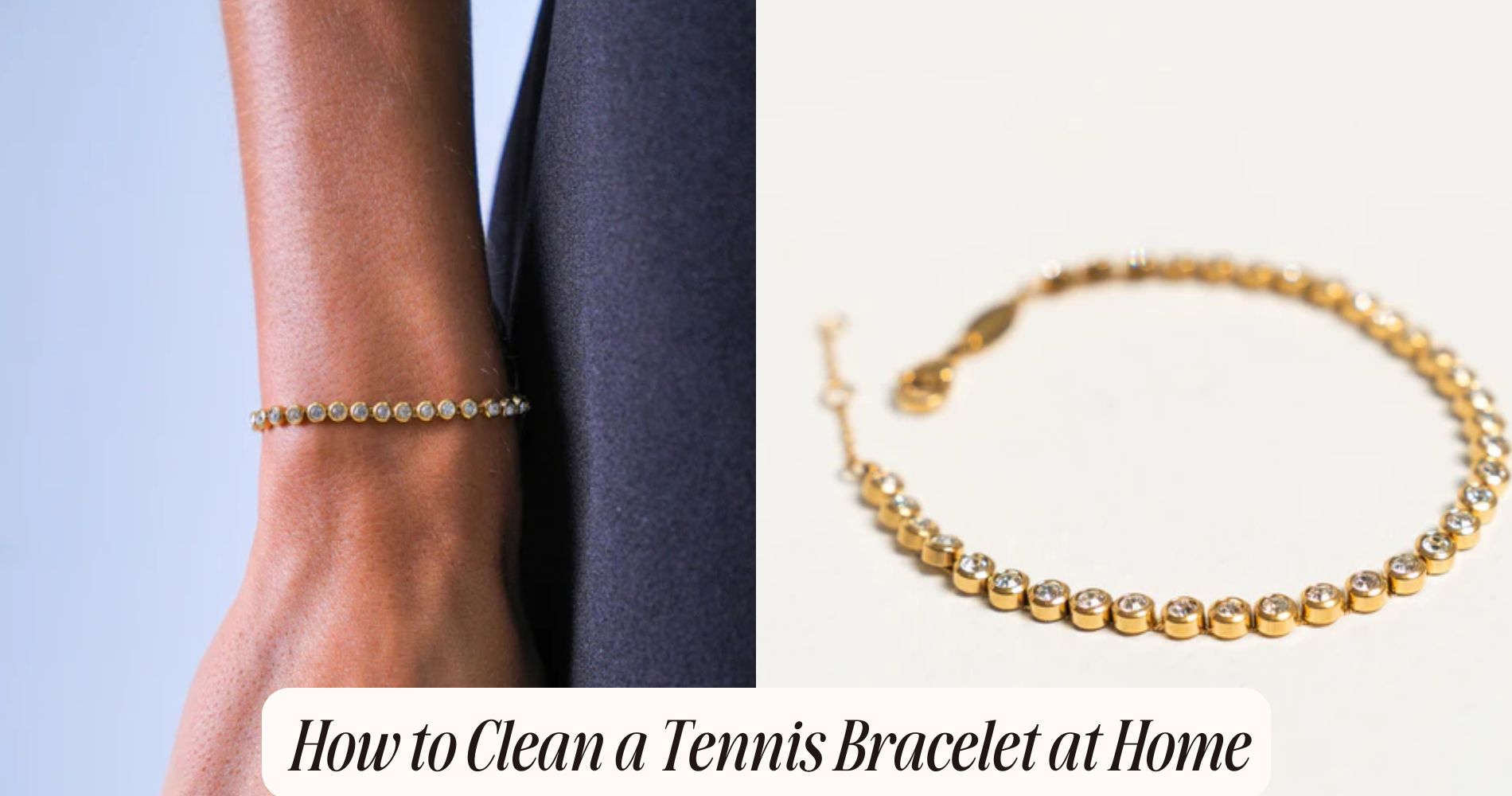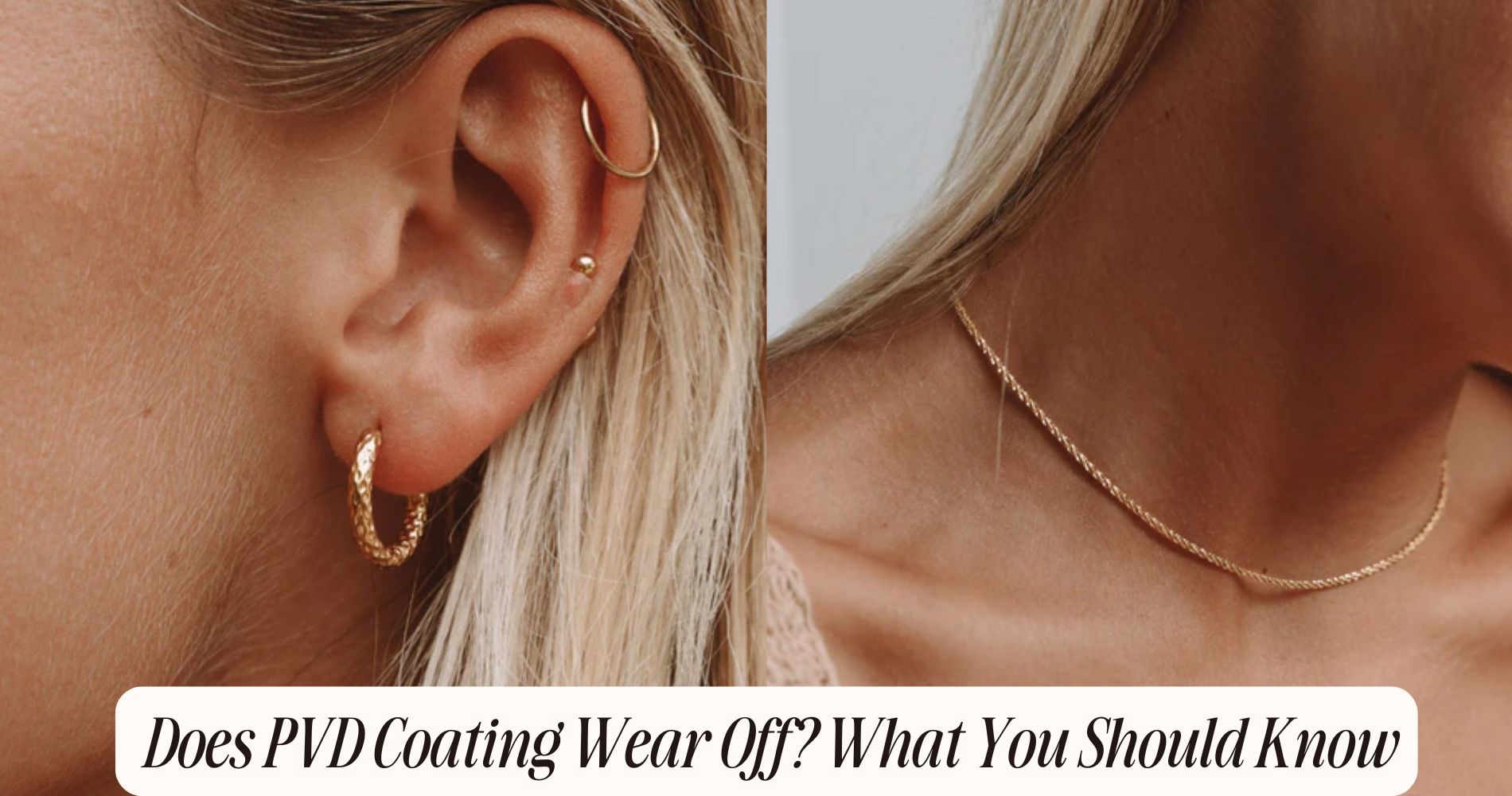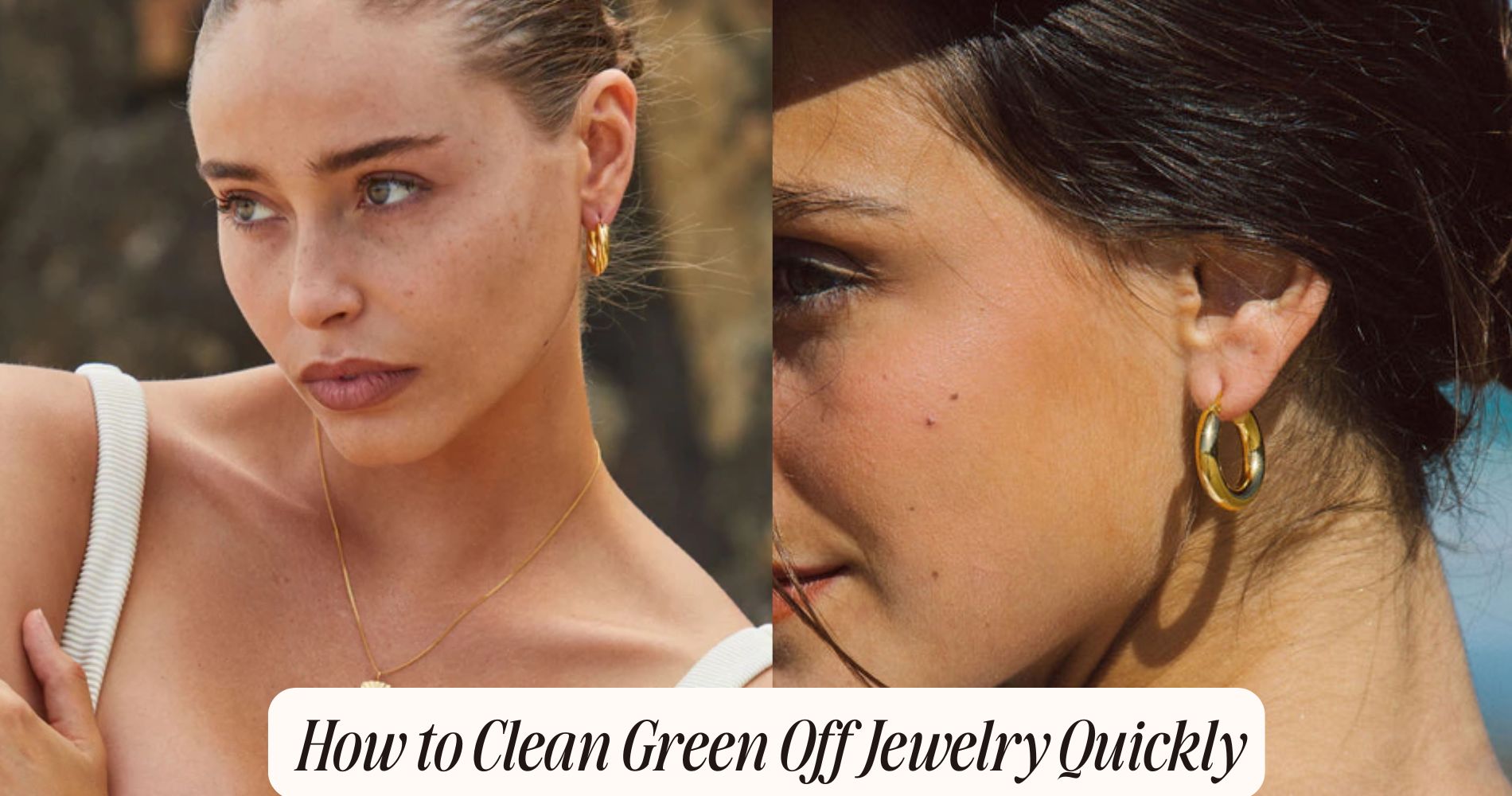
How to Clean a Tennis Bracelet at Home
How to clean a tennis bracelet at home? To clean your tennis bracelet at home, gather mild dish soap, warm water, a soft-bristled brush, and a lint-free cloth. First, inspect the bracelet for any damage. Next, mix one part detergent to three parts water in a bowl and soak the bracelet for 15-20 minutes. Then, gently scrub it with the soft brush, focusing on crevices. Rinse thoroughly with lukewarm water and pat it dry with a soft cloth. For extra shine, use a jewelry polishing cloth. Finally, to keep your bracelet safe, store it properly. There's plenty more to discover about maintaining your jewelry's brilliance in our Waterproof Bracelets collection.
Gather Your Cleaning Supplies
To effectively clean your tennis bracelet, you'll need to gather a few essential supplies. Start with a soft, lint-free cloth, which will help you wipe away dirt and oils without scratching the metal or stones.
You'll also want a small, soft-bristled brush—an old toothbrush works great—to gently scrub between the links and around the stones where grime can accumulate.
Next, pick up a mild dish soap and warm water to create a gentle cleaning solution. Avoid harsh chemicals, as they can damage the metal or stones. A small bowl will help you mix the solution and soak your bracelet for a few minutes if needed.
Additionally, having a microfiber cloth on hand is helpful for drying and polishing your bracelet after cleaning.
Finally, consider using a jewelry polishing cloth to maintain the shine of your metal and enhance your jewelry maintenance routine.
Inspect Your Tennis Bracelet
Before you start cleaning, take a moment to inspect your tennis bracelet for any signs of damage.
Look closely at the metal links for breaks or bends, and verify the clasp functions properly.
Additionally, check the condition of each stone to confirm they're secure and free from scratches or chips.
Check for Damage
Inspecting your tennis bracelet for damage is essential to confirm its longevity and maintain its sparkle. Start by examining the metal for any signs of tarnish. Regular checks can aid in tarnish prevention, confirming your bracelet remains in pristine condition. If you notice any discoloration, it may require immediate cleaning to prevent further deterioration.
Next, focus on the clasp functionality. Confirm the clasp opens and closes smoothly without any stiffness or resistance. A malfunctioning clasp can lead to loss, so if it feels loose or doesn't catch properly, consider having it repaired.
Additionally, look for any bent or broken links in the chain. Over time, wear and tear can weaken these connections, compromising the bracelet's structural integrity. If you find any damaged links, it's best to address them swiftly to avoid further issues.
Lastly, pay attention to any irregularities in the design, such as loose settings or uneven stones. These can detract from the bracelet's overall appearance and may require professional help.
Assess Stone Condition
Once you've confirmed the metal and clasp of your tennis bracelet are in good shape, it's time to turn your attention to the stones.
Begin by inspecting each stone type for any signs of damage, such as chips, scratches, or discoloration. Common stone types in tennis bracelets include diamonds, sapphires, and cubic zirconia. Each type has different cleaning requirements, so knowing the specific needs of your stones is essential.
If you notice any dirt or buildup, consider how frequently you wear the bracelet. For daily wear, you should clean it more often—ideally every couple of weeks. If it's a piece you only wear occasionally, a monthly cleaning might suffice. Always use a gentle cleaner suitable for your stone type; harsh chemicals can cause permanent damage.
Pay particular attention to the settings around the stones, too. Dirt can accumulate there and dull the sparkle of your stones.
After your inspection, you'll be better equipped to determine the appropriate cleaning method and frequency for maintaining the brilliance of your tennis bracelet. Regular assessments will help extend its life and keep it looking stunning.
Prepare a Cleaning Solution
To effectively prepare a cleaning solution for your tennis bracelet, start by selecting a gentle detergent or a specialized jewelry cleaner. Avoid harsh chemicals that can damage both the metal and the stones. If you choose a detergent, look for one that's free from dyes and fragrances to minimize the risk of irritation.
Next, gather your solution ingredients. Combine a few drops of your selected detergent with warm water in a small bowl. The water shouldn't be too hot, as extreme temperatures can harm some stones. A good ratio is about one part detergent to three parts water. This balance guarantees that the solution is effective yet mild enough to protect your bracelet.
For a specialized jewelry cleaner, follow the manufacturer's instructions for dilution, as different products may have different recommendations.
Whether you're using a homemade solution or a commercial cleaner, remember that the goal is to create a safe environment for your bracelet to be cleaned without risking any damage.
Once your solution is ready, you can confidently move on to the next steps in the cleaning process, assuring your tennis bracelet shines beautifully.
Soak the Bracelet
Now that you've prepared your cleaning solution, it's time to soak the bracelet.
Begin by gently placing your tennis bracelet into the solution, guaranteeing it's fully submerged. Let it soak for about 15 to 20 minutes. This process allows the cleaning solution to penetrate and loosen any dirt or grime accumulated over time.
If you've been wearing the bracelet frequently, consider soaking it more often to maintain its sparkle and shine. Regular cleaning frequency helps prevent the buildup of oils and dirt, which can dull the brilliance of your jewelry.
While the bracelet soaks, avoid shaking or stirring the solution, as this can cause unnecessary wear on the delicate links. Instead, just let it sit undisturbed.
If you notice any particularly dirty areas, take note for the next step where you'll gently scrub those spots.
For best results, incorporate these maintenance tips into your routine: soak your bracelet every few weeks or after special occasions when it's been exposed to lotions, perfumes, or sweat.
Gently Scrub With a Soft Brush
After the soaking period, it's time to gently scrub your tennis bracelet with a soft brush. Choose a brush with soft bristles, as they're effective in removing dirt and grime without scratching the delicate metal or stones. You can use a clean, unused toothbrush or a specialized jewelry brush designed for this purpose.
Begin by holding your bracelet over a soft cloth or towel to catch any debris that may come loose during cleaning. Lightly dip the soft bristle brush into your cleaning solution, making sure it's not overly saturated.
Start scrubbing gently, focusing on the crevices between the stones and the metal links. Use circular motions to lift away any buildup while being cautious around the gemstones to prevent damage.
Pay special attention to areas where dirt may accumulate, such as the underside of the bracelet and around the clasps. If you notice stubborn spots, you can apply a bit more pressure, but always be gentle. This cleaning technique guarantees you maintain the bracelet's brilliance and integrity.
Once you've scrubbed thoroughly, you're ready for the next step in the cleaning process.
Rinse Thoroughly With Water
After scrubbing your tennis bracelet, rinsing it thoroughly with water is essential to remove any soap residue.
Use lukewarm water to guarantee that you don't damage any delicate stones or settings.
Once rinsed, gently pat the bracelet dry with a soft cloth to avoid scratching its surface.
Importance of Rinsing
Rinsing your tennis bracelet thoroughly with water is vital for maintaining its shine and integrity. After cleaning the bracelet with a gentle solution, any remaining soap or cleaning solution can leave a film that dulls its sparkle. By rinsing, you make certain that all residues are removed, allowing the bracelet to shine brightly.
Rinsing benefits go beyond mere aesthetics. It helps prevent any potential irritation caused by leftover cleaning agents, especially if you wear your bracelet frequently. Furthermore, rinsing helps eliminate dirt and oils that might cling to the surface, keeping your bracelet looking pristine.
When it comes to rinsing techniques, you should gently run water over the bracelet, making sure that every part, including the clasp and stones, is thoroughly rinsed. Avoid using abrasive materials, as they can scratch the surface. Instead, let the water flow freely to wash away any remnants of the cleaning solution.
This simple step not only enhances the appearance of your tennis bracelet but also prolongs its life, allowing you to enjoy its beauty for years to come. Taking the time to rinse properly is a small but vital part of your bracelet care routine.
Recommended Water Temperature
To guarantee your tennis bracelet remains in top condition, pay attention to the water temperature when rinsing. The right water temperature can enhance the cleaning process, making it more effective in removing residues from various cleaning solution types you might've used.
Generally, lukewarm water is ideal; it's warm enough to dissolve any remaining soap or cleaning agents without causing damage to the precious stones or metal settings.
Using too hot water can lead to loosening of the stones or tarnishing of the metal, while cold water mightn't be effective in dislodging stubborn dirt. The water temperature benefits your bracelet by ensuring that it's cleaned thoroughly without risking any structural integrity.
When rinsing, let the water flow gently over the bracelet, allowing it to wash away any remnants of the cleaning solution. This step is vital, as leftover chemicals can tarnish the bracelet over time.
Always make sure to check the temperature with your hand before rinsing; it should feel comfortable and warm, not hot. By following these guidelines, you'll keep your tennis bracelet sparkling and in excellent shape for years to come.
Drying Techniques After Rinsing
Once you've thoroughly rinsed your tennis bracelet, it's important to dry it properly to prevent water spots and maintain its shine. You have two primary techniques to choose from: towel drying and air drying.
For towel drying, take a soft, lint-free cloth and gently pat the bracelet. Avoid rubbing, as this could scratch the surface. Make sure to get into the crevices between the stones where water might linger. The key is to be gentle yet thorough, making certain you remove any excess moisture.
If you prefer air drying, lay the bracelet flat on a clean, dry towel. This method allows air to circulate around the bracelet, effectively evaporating any remaining water. Leave it in a well-ventilated area, away from direct sunlight, which can cause damage to the metal or stones over time.
Whichever method you choose, verify the bracelet is completely dry before wearing or storing it. This attention to detail will help maintain its sparkle and longevity, keeping your tennis bracelet looking stunning for years to come.
Dry the Bracelet Properly
After thoroughly cleaning your tennis bracelet, drying it properly is vital to maintain its shine and prevent any damage.
Begin by choosing the right drying method. A soft, lint-free cloth is ideal for gently patting the bracelet dry. Avoid using paper towels, as they can scratch the metal or gemstones.
If you want to air dry your bracelet, place it on a clean, dry surface, ensuring it's away from direct sunlight and heat sources. This helps avoid moisture, which can lead to tarnishing or rusting, especially if your bracelet has metal components.
For intricate designs, you might want to use a soft toothbrush to gently sweep between the stones, ensuring no trapped moisture remains.
Always inspect the bracelet after drying to confirm it's completely moisture-free.
If you notice any stubborn spots, repeat the drying process carefully. It's essential to handle the bracelet with care during this stage since rough handling can loosen stones or damage the setting.
Polish for Extra Shine
Polishing your tennis bracelet can greatly enhance its luster and overall appearance. To achieve that stunning shine, you'll need to use the right polishing techniques.
Start by selecting a suitable jewelry polishing cloth, ideally one designed for silver or gold. Avoid paper towels, as they can scratch the surface.
Begin by gently rubbing the cloth over the bracelet in a circular motion. Focus on areas that may have lost their shine, such as the links and the clasp. Be careful around any gemstones; you don't want to damage them.
For a deeper clean, consider using a jewelry polishing solution specifically made for your bracelet's metal type. Apply a small amount to a soft cloth and rub it gently over the bracelet.
Keep an eye on the finish as you polish. You should see immediate shine enhancement. If you notice stubborn tarnish or dirt, repeat the process carefully, ensuring you're not applying too much pressure.
Store Your Bracelet Safely
To keep your tennis bracelet in pristine condition, proper storage is vital. First, find a designated spot that guarantees secure placement, such as a soft-lined jewelry box or a dedicated compartment within your organizer.
Avoid tossing it into a drawer or mixing it with other jewelry, as this can lead to scratches or tangling.
When storing your bracelet, consider wrapping it in a soft cloth or placing it in a small pouch. This extra layer of protection minimizes exposure to dust and potential damage.
If your bracelet features delicate stones or intricate designs, you may want to store it separately from other pieces to prevent any undue stress on the settings.
Additionally, keep your bracelet away from direct sunlight and extreme temperatures, which can affect the materials over time.
Regularly check the storage area for any signs of moisture or damage, as a dry, stable environment is vital for maintaining your bracelet's integrity.
Frequently Asked Questions
Can I Use Toothpaste to Clean My Tennis Bracelet?
Using toothpaste isn't recommended for cleaning your tennis bracelet due to its abrasiveness. Instead, consider milder cleaning alternatives like soapy water or a jewelry cleaner, which can effectively restore its shine without risking damage.
How Often Should I Clean My Tennis Bracelet?
You should clean your tennis bracelet regularly for ideal maintenance. Aim for every few weeks, depending on usage. This cleaning frequency helps prevent dirt buildup and keeps your jewelry sparkling, ensuring it always looks its best.
Is It Safe to Use Ultrasonic Cleaners?
Using an ultrasonic cleaner can be safe, but you need to make certain your jewelry's materials are compatible. Always research jewelry cleaning methods and consult expert advice to avoid damaging your cherished pieces during the cleaning process.
What if My Bracelet Has Loose Stones?
If your bracelet has loose stones, check its stone security immediately. It's best to schedule a professional inspection to guarantee proper settings and avoid losing any stones, which could lead to costly repairs or replacements.
Can I Clean My Bracelet With Dish Soap?
Yes, you can use dish soap as a cleaning solution for your bracelet. Just mix it with warm water, soak your bracelet briefly, and gently scrub. Regular maintenance tips help keep your jewelry sparkling and intact.
Conclusion
By following these simple steps, you can keep your tennis bracelet looking stunning and well-maintained. Regular cleaning not only enhances its sparkle but also prolongs its lifespan. Always remember to use gentle methods to avoid damage and store your bracelet safely when it's not in use. With a little care and attention, your favorite piece of jewelry will continue to shine brilliantly for years to come. Enjoy showing off your beautifully clean tennis bracelet!























Leave a comment
This site is protected by hCaptcha and the hCaptcha Privacy Policy and Terms of Service apply.